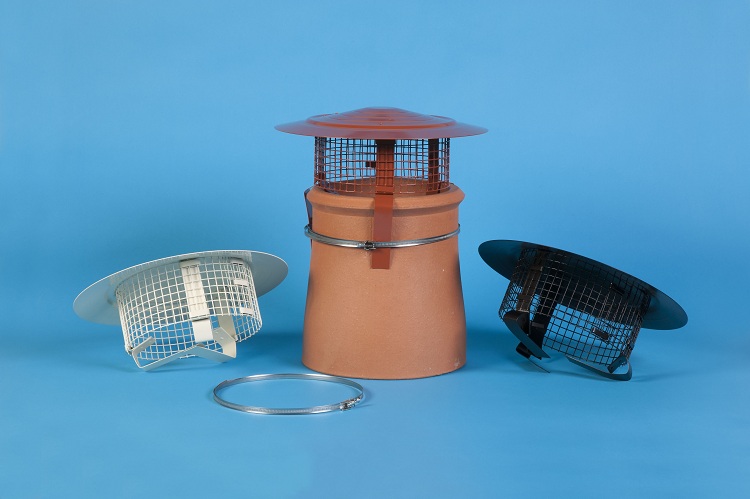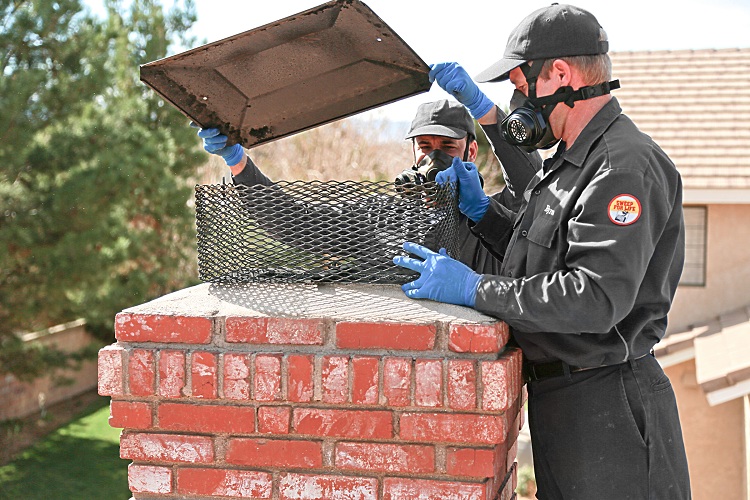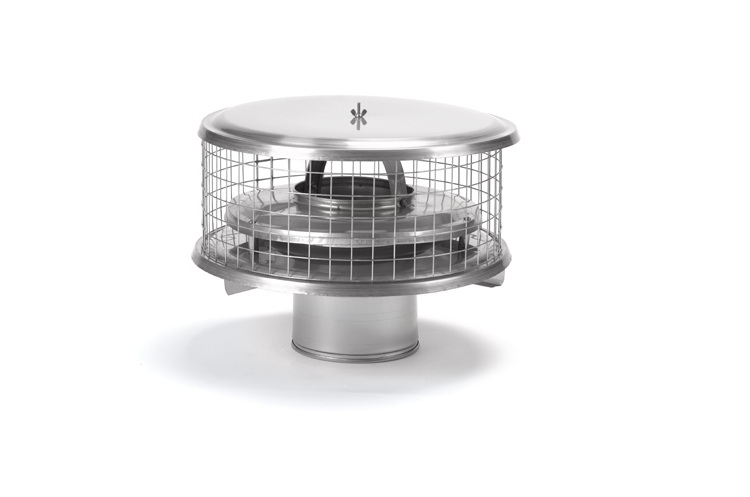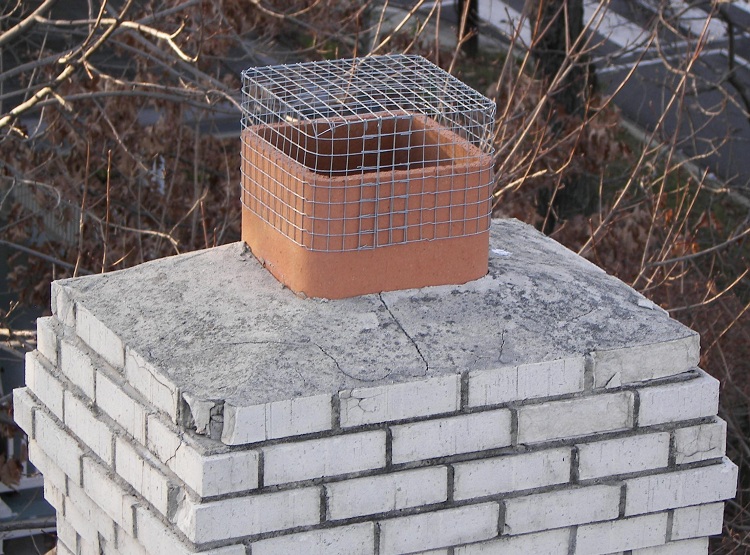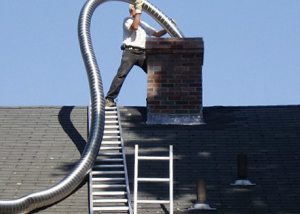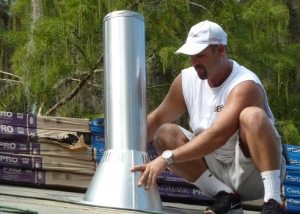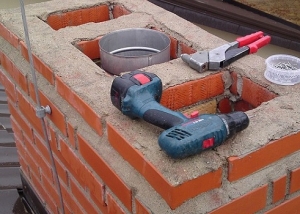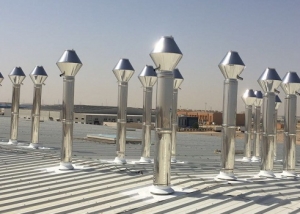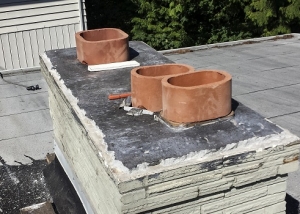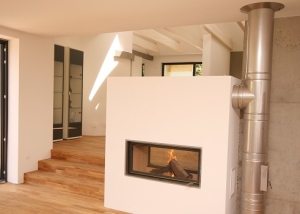The chimney spark arrestor is a device that is used to catch sparks flying out of the chimney and is a nozzle equipped with a metal mesh and a protective visor from above. In terms of its performance, the spark arrester is similar to another device mounted on a chimney - a deflector. However, the cost of the spark arrestor is lower, it can be easily assembled with your own hands.
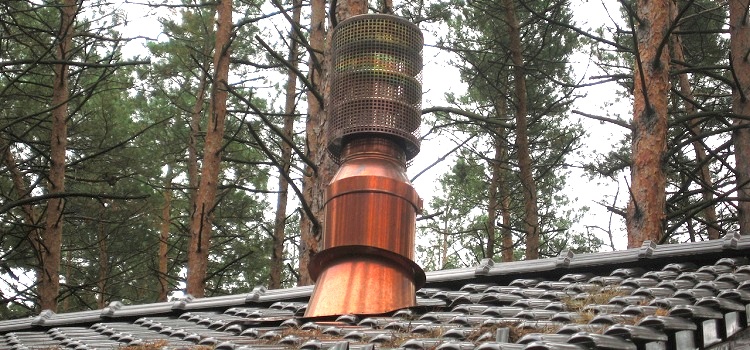
To prevent ignition of the roof from a spark flying out of the chimney, a special nozzle is installed on the pipe - a spark arrester
Content
What is a spark arrester?
Absolutely any design that is associated with the processing of fuel and the removal of combustion products outside the heated premises is a danger to buildings. Especially if the material of the house does not have fire resistance (for example, wood).
That is why when building a house you need to follow all fire safety rules. These rules apply not only to the stove or boiler, but also to the chimney design, since the fuel processing process is accompanied by the emission of combustion products into the chimney. This process, as a rule, is accompanied by the appearance of sparks, which can lead to ignition of the roof. To protect themselves and their home, they install a special device - a spark arrester.
A spark catcher is a device that is mounted directly on a chimney. The composition of such a device includes several structural elements, such as:
- housing;
- a grid that catches and extinguishes sparks;
- flame extinguishing element;
- visor.
Spark Arrester Features
Like any other device, the spark arrester on the chimney has its own characteristics. Consider the main ones:
- such devices are mounted on chimneys of furnaces that run on solid fuel;
- the mesh size of the spark-catching grid according to the rules should not be more than 5 mm;
- the installation of a spark arrestor is mandatory if the roof is made of flammable materials;
- spark arresters are also necessary if the chimney structure is mounted in a straight line (in baths, saunas, etc.);
- in addition, such a device prevents the entry of debris or birds into the channel.
Important! Firewood, which contains many resins, is not suitable for straight chimneys. If you neglect this, the resin deposited on the grid will clog it and the design will decrease traction.
- spark-catching mesh must be regularly cleaned;
- The installation of a spark arrestor is obligatory introduced into the chimney design.
Assembling such a device with your own hands is quite simple, however, you should carefully consider the choice of material for the spark arrester. Not every material is suitable for such purposes, for example, if ferritic steel or galvanized metal is used, this can lead to quick wear of the device.
The most suitable material for the spark arrester is stainless steel, which is 5 mm thick.Stainless steel products have good strength characteristics, as well as resistance to corrosion. In addition, they have a high coefficient of thermal stability.
Types and principle of operation of spark arrestors
Today, there are many types of spark arresters that differ in design features, however, two types are most popular:
- spark arrester, which is a casing made of metal mesh;
- spark arrester made in the form of a deflector.
The main requirement for such devices is that they should not interfere with normal traction in the structure. Combustion products must pass through the chimney without encountering any obstacles. In addition, the spark arrester must extinguish all sparks that enter through the pipes.
The sizes of such products vary depending on the diameter of the pipe. The diameter of spark arresters can be from 80 to 550 mm. The size of the visor is directly dependent on the diameter of the connecting pipe, which is worn on the chimney. This relationship is described in the table below.
Table 1
| Du connecting pipe, mm | Visor, mm |
| 80 | 160 |
| 100 | 200 |
| 110 | 220 |
| 120 | 250 |
| 130 | |
| 140 | 280 |
| 150 | 300 |
| 160 | |
| 180 | 360 |
| 200 | 400 |
| 230 | |
| 250 | 450 |
| 280 | |
| 300 | 500 |
| 350 | 550 |
| 400 | 600 |
| 450 | 650 |
| 500 | 750 |
| 550 | 800 |
The principle of operation of such a device as a spark catcher is quite simple. Moreover, absolutely all varieties of these devices for chimneys work the same way:
- Combustion products pass through a chimney through a pipe channel.
- At the head they come across an obstacle (spark arrester) and change the direction of movement along the axis.
- At the exit of the structure, sparks pass through a spark-catching grid that extinguishes them.
Simple spark arrestor options
If necessary, you can always buy a ready-made device and mount it on a chimney, however, many owners are accustomed to independently improve their home. Making a spark catcher yourself is very simple:
1. The simplest option that can be made at home is the device represented by a plug for a pipe with holes drilled in it. It is worth remembering that if you decide to make such a spark arrester, you must first take care of choosing the diameter of the plug. The plug, from which the spark catcher will be made in the future, must have a cross section greater than the diameter of the chimney. This is necessary in order to be able to put such a simple device on a chimney without special problems.
The implementation of such a device is not difficult, however, there are some difficulties that are associated with the size and number of holes in the plug. Incorrect calculation of these indicators can lead to a decrease in draft in the structure. In addition, there is one more minus of using such a cylindrical device - during operation it is covered with soot, resulting in an unpleasant odor from the furnace.
Advice! If sparks in the chimney occur too often or in large quantities, you should pay attention to its draft. If the thrust is too strong, it is worth reducing it, then this problem should disappear.
2. The second simple option that can replace a full-fledged spark arrestor is a metal mesh, which is fixed with a special clamp on a chimney. The disadvantages of this product include:
- the grid is quickly clogged with soot, which entails a decrease in traction in the structure;
- not highly effective, therefore, may not give the expected results.
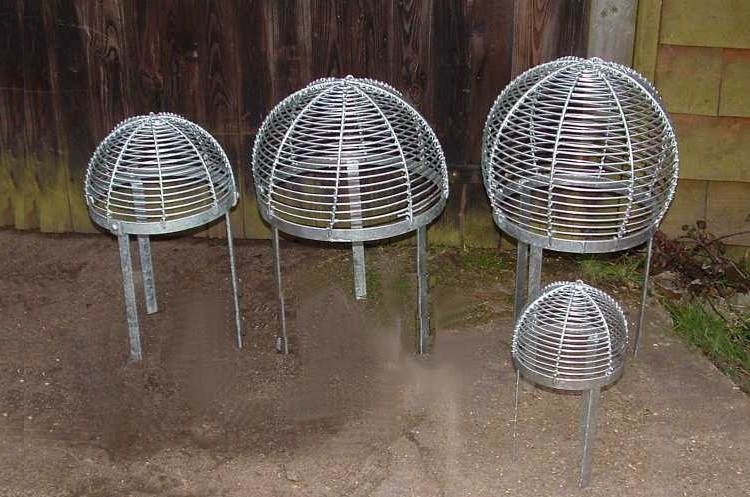
When making a spark arrestor with your own hands, you should choose a dome shape, such a device will be effective
3. Mounting a dome-shaped grid at the end of the chimney. The domed mesh is considered the most effective device among alternatives to high-grade spark catchers.
DIY spark arrestor
In order to assemble a spark arrester on a chimney pipe at home, you will need the following list of tools:
- hammer;
- yardstick;
- welding unit or special rivets for connecting the elements of the device;
- pliers;
- clamps;
- drill with a set of drills;
- screwdriver;
- scissors for cutting metal;
- Bulgarian.
For the manufacture of this device, it is recommended to select steel that has anti-corrosion properties. The thickness of the wire rods should be as small as possible. The smaller the thickness of the rods, the longer it takes for the network to clog with soot.
Advice! If you can’t bend the metal mesh, you can use an ordinary hammer. Tap them on the grid - this will relieve stress from the metal and it can be bent without any problems.
Consider the procedure for assembling a spark arrestor with your own hands:
- First, you need to measure the dimensions of the chimney and make a sketch of the future details of the device.
- It is necessary to cut cardboard layouts, which then serve as a stencil for the manufacture of steel parts.
- The spark arrester mesh can be purchased, or you can make it yourself with steel rods. The diameter of such rods should be from 1 to 6 mm.
- Using welding, we join the parts into a single design. After joining the individual elements of the spark arrester, it is necessary to conduct a thorough cleaning of the joints.
- Then we fix all the elements of the spark catcher with steel rivets.
After the product is ready, you can begin to install it on the chimney.
Additionally, you can assemble a deflector, for this you need:
- Cut a suitable visor out of metal.
- Then bend the visor at the desired angle and fix the bending points with steel rivets.
- The finished visor is mounted on the base of the spark arrester, using all the same rivets.
Features of installation and operation of a spark arrester
For the correct installation of such a device, the dimensions of its cross section must be selected in accordance with the same indicator of the chimney. The easiest way to install a spark arrestor is to insert it inside the chimney without any additional fasteners. However, this method is not particularly reliable. The operation of the spark arrester requires regular preventive cleaning of its mesh from soot, so it is installed in such a way that the device can be easily removed at any time. It is strictly forbidden to weld the device to the chimney - the structure must in all cases be removable.
Even if your roof is made of non-combustible materials, there is a danger that sparks flying out of the chimney will fall on objects and buildings that are located in your yard and ignite them. Therefore, the installation of a spark arrester is recommended in all cases without exception.
